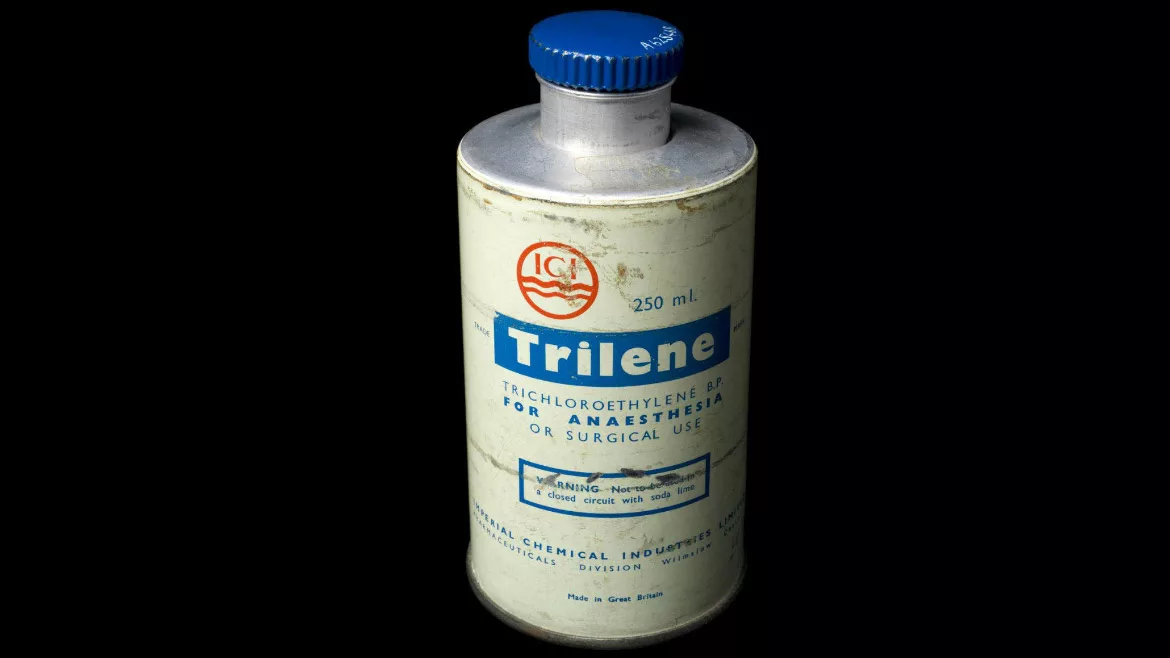Why TCE is an 'unreasonable risk' even when it's used as intended
EPA's finalized revision to the Toxic Substances Control Act notes trichloroethylene (TCE) poses unreasonable risks to human health. The next step is to develop risk management rules.

Originally developed as an anesthetic, Trichloroethylene, or TCE, can cause kidney cancer, according to National Cancer Institute. Photo courtesy of Science Museum Group, CC BY-NC-SA
On Jan. 9, the U.S. Environmental Protection Agency (EPA) finalized a revision to the Toxic Substances Control Act (TSCA) risk determination for trichloroethylene (TCE), finding that TCE, as a whole chemical substance, presents an unreasonable risk of injury to human health when evaluated under its conditions of use. The next step in the process is to develop a risk management rulemaking to identify and require the implementation of measures to manage these risks.
Uses and Risks Associated with TCE
TCE is a volatile organic compound used mostly in industrial and commercial processes. Consumer uses include cleaning and furniture care products, arts and crafts, spray coatings and automotive care products like brake cleaners.
In the revised risk determination based on the 2020 risk evaluation, EPA found that TCE presents unreasonable risk to the health of workers, occupational non-users (workers nearby but not in direct contact with this chemical), consumers, and bystanders. EPA identified risks for adverse human health effects not related to cancer, including neurotoxicity and liver effects, from acute and chronic inhalation and dermal exposures to TCE. EPA also identified risks for cancer from chronic inhalation and dermal exposures to TCE.
EPA used the whole chemical risk determination approach for TCE in part because there are benchmark exceedances for multiple conditions of use (spanning across most aspects of the chemical life cycle from manufacturing (import), processing, commercial use, consumer use and disposal) for health of workers, occupational non-users, consumers, and bystanders, and because the health effects associated with TCE exposures are severe and potentially irreversible (including developmental toxicity, reproductive toxicity, liver toxicity, kidney toxicity, immunotoxicity, neurotoxicity and cancer).
Overall, EPA determined that 52 of the 54 conditions of use EPA evaluated drive the unreasonable risk determination. Two out of 54 conditions of use do not drive the unreasonable risk: consumer use of TCE in pepper spray and distribution in commerce. The revised risk determination supersedes the condition of use-specific no unreasonable risk determinations that were previously issued by order under section 6(i) of TSCA in the 2020 TCE risk evaluation.
The revised risk determination for TCE does not reflect an assumption that workers always and appropriately wear personal protective equipment (PPE), even though some facilities might be using PPE as one means to reduce workers’ exposure. This decision should not be viewed as an indication that EPA believes there is widespread non-compliance with applicable Occupational Safety and Health Administration (OSHA) standards. In fact, EPA has received public comments from industry respondents about occupational safety practices currently in use at their facilities and will consider these comments, as well as other information on use of PPE, engineering controls and other ways industry protects its workers as potential ways to address unreasonable risk during the risk management process. The consideration of this information will be part of the risk management process.
EPA understands there could be occupational safety protections in place at some workplace locations. However, not assuming use of PPE in its baseline exposure scenarios reflects EPA’s recognition that certain subpopulations of workers exist that may be highly exposed because:
- They are not covered by OSHA standards (e.g., self-employed individuals and public sector workers who are not covered by a state plan);
- Their employers are out of compliance with OSHA standards;
- OSHA’s chemical-specific Permissible Exposure Limits (largely adopted in the 1970’s) are described by OSHA as being “outdated and inadequate for ensuring protection of worker health;” or
- The OSHA permissible exposure limit alone may be inadequate for ensuring protection of worker health, as is the case for TCE.
As EPA moves forward with a risk management rulemaking for TCE, the agency will strive for consistency with existing OSHA requirements or best industry practices when those measures would address the identified unreasonable risk. EPA will propose occupational safety measures in the risk management process that would meet TSCA’s statutory requirement to eliminate unreasonable risk of injury to health and the environment.
Next Steps for TCE
EPA is now moving forward on risk management to address the unreasonable risk presented by TCE. While the risk evaluation included a description of the more sensitive endpoint (fetal heart malformations), it was not relied on to determine whether there is unreasonable risk from TCE because of direction not to do so that was provided by the previous political leadership. Unreasonable risks were nevertheless identified for most uses of TCE, but the magnitude of the risk from exposures to TCE would have been greater had EPA relied upon the fetal cardiac defect (CHD) endpoint that had been used in previous EPA peer-reviewed assessments. Therefore, EPA developed existing chemical exposure limits based on both the immune endpoint and the CHD endpoint in support of risk management, and the public will have an opportunity to comment on these in the forthcoming proposed regulatory action.
Note that in taking this action, EPA has not conducted a new scientific analysis on this chemical substance and the risk evaluation continues to characterize risks associated with individual conditions of use in the risk evaluation of TCE in order to inform risk management.
In June 2021, EPA announced a path forward for the first 10 chemicals to undergo risk evaluation under TSCA to ensure the public is protected from unreasonable risks from these chemicals in a way that is supported by science and the law. The revised risk determination for TCE was developed in accordance with these policy changes, as well as the Biden-Harris Administration’s Executive Orders and other directives, including those on environmental justice, scientific integrity and regulatory review. EPA’s revisions ensure that the TCE risk determination better aligns with the objectives of protecting health and the environment under amended TSCA.
Separately, EPA is conducting a screening-level approach to assess risks from the air and water pathways for several of the first 10 chemicals, including TCE. The goal of the screening approach is to evaluate the surface water, drinking water, and ambient air pathways for TCE that were excluded from the 2020 risk evaluation, and to determine if there are risks that were unaccounted for in that risk evaluation. EPA expects to describe its findings regarding the chemical-specific application of this screening-level approach in its proposed risk management rule for TCE.
Additionally, EPA expects to focus its risk management action on the conditions of use that drive the unreasonable risk. However, EPA is not limited to regulating the specific activities found to drive unreasonable risk and may select from among a wide range of risk management requirements. As a general example, EPA may regulate upstream activities (e.g., processing, distribution in commerce) to address downstream activities (e.g., consumer uses) driving unreasonable risk, even if the upstream activities do not drive the unreasonable risk.


